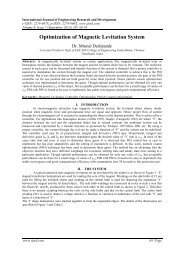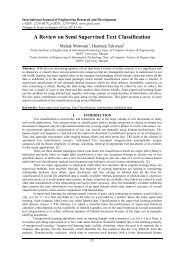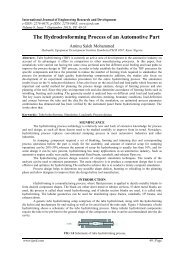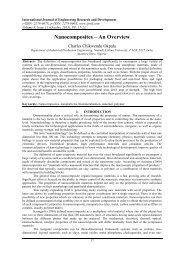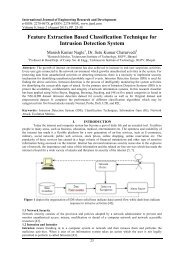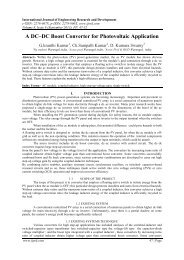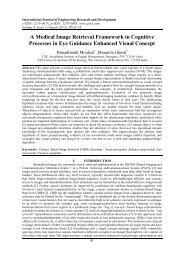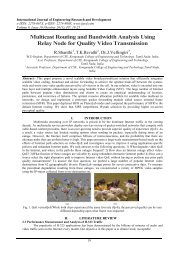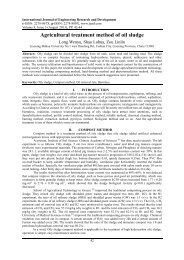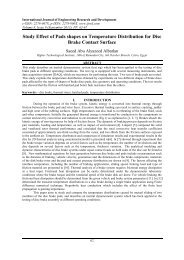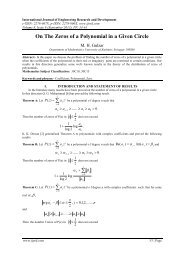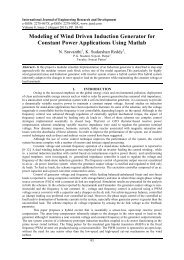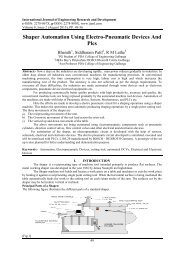Clitoria Ternatea- Extracts As Corrosion Inhibitor for Mild Steel in Acid Medium
You also want an ePaper? Increase the reach of your titles
YUMPU automatically turns print PDFs into web optimized ePapers that Google loves.
International Journal of Eng<strong>in</strong>eer<strong>in</strong>g Research and Development<br />
e-ISSN: 2278-067X, p-ISSN: 2278-800X, www.ijerd.com<br />
Volume 8, Issue 5 (August 2013), PP.64-67<br />
<strong>Clitoria</strong> <strong>Ternatea</strong>- <strong>Extracts</strong> <strong>As</strong> <strong>Corrosion</strong> <strong>Inhibitor</strong> <strong>for</strong><br />
<strong>Mild</strong> <strong>Steel</strong> <strong>in</strong> <strong>Acid</strong> <strong>Medium</strong><br />
Ananth Kumar a , A.Sankar A , M.Kumaravel S.Rameshkumar b<br />
a Kandaswami Kandar's College, P. velur, Namakkal-638 182, India<br />
b PSG College of Technology Peelamedu, Coimbatore 641 004, India<br />
Abstract:- The corrosion <strong>in</strong>hibitive action of flower extracts of <strong>Clitoria</strong> ternata flower on mild steel corrosion<br />
<strong>in</strong> 0.5 M H2SO4 solution was studied us<strong>in</strong>g weight loss method, potentiodynamic polarization and EIS<br />
measurements. The results obta<strong>in</strong>ed <strong>in</strong>dicate that the extracts functioned as good <strong>in</strong>hibitors <strong>in</strong> 0.5 M H2SO4<br />
solution. Inhibition efficiency was found to <strong>in</strong>crease with extract concentration. The adsorption of constituents<br />
<strong>in</strong> the plant extract on the surface of the metal is proposed <strong>for</strong> the <strong>in</strong>hibition behavior.<br />
Keywords:- <strong>Inhibitor</strong>, Mass loss, Impedance, Polarization, <strong>Clitoria</strong> ternata.<br />
I. INTRODUCTION<br />
<strong>Corrosion</strong> <strong>in</strong>hibitors are widely used <strong>in</strong> <strong>in</strong>dustry to reduce the corrosion rate of metals and alloys <strong>in</strong><br />
contact with aggressive environments. Most of the corrosion <strong>in</strong>hibitors are synthetic chemicals, expensive, and<br />
very hazardous to environments. There<strong>for</strong>e, it is desirable to source <strong>for</strong> environmentally safe <strong>in</strong>hibitors [1-3].<br />
There are some reports on the <strong>in</strong>hibition effects of non-toxic compounds on the<br />
<strong>Corrosion</strong> of metals. We have recently reported the <strong>in</strong>hibition effect of am<strong>in</strong>o acids on the steel [1] and<br />
alum<strong>in</strong>um [4] corrosion <strong>in</strong> acidic media. The rare earth metals have been proposed as corrosion <strong>in</strong>hibitors [5-8].<br />
The <strong>in</strong>hibition effects of some non-toxic organic compounds have been also reported <strong>for</strong> steel corrosion [9, 10]<br />
but they are expensive. The aim of this study was to <strong>in</strong>vestigate the <strong>in</strong>hibition effect of <strong>Clitoria</strong> ternata flower<br />
extract as a cheap, raw and non-toxic corrosion <strong>in</strong>hibitor on mild steel corrosion <strong>in</strong> 0.5M H2SO4. The<br />
electrochemical measurements were used to evaluate the <strong>in</strong>hibition efficiencies.<br />
II. MATERIAL AND METHODS<br />
2.1 Preparation of <strong>Clitoria</strong> ternata flower extract:<br />
An aqueous extract of <strong>Clitoria</strong> ternata flower extract was prepared by gr<strong>in</strong>d<strong>in</strong>g 5g of plant flower, with<br />
distilled water, filter<strong>in</strong>g the suspend<strong>in</strong>g impurities, and mak<strong>in</strong>g up to 100 ml. The extract was used as corrosion<br />
<strong>in</strong>hibitor <strong>in</strong> the present study.<br />
2.2 PREPARATION OF SPECIMENS<br />
Carbon steel specimens (0.022% S, 0.038% Mn, 0.027%P, 0.086 C) of dimension 1.0 cm<br />
*4.0cm*0.2cm were polished to a mirror f<strong>in</strong>ished with the emery sheets of various grades and degreased with<br />
trichloroethylene.<br />
2.3 Weight loss method.<br />
Carbon steel specimens <strong>in</strong> triplicate were immersed <strong>in</strong> 100 mL of the <strong>in</strong>hibited and un<strong>in</strong>hibited 0.5M<br />
H2SO4 solutions <strong>in</strong> the presence and absence of KI <strong>for</strong> two hours. The weight of each specimen be<strong>for</strong>e and after<br />
immersion was determ<strong>in</strong>ed us<strong>in</strong>g shimadzu balance, model Ay 62.The <strong>in</strong>hibition efficiency (IE) was then<br />
calculated us<strong>in</strong>g the expression;<br />
.<br />
I<br />
Where W1and W2 are the corrosion rates <strong>in</strong> the absence and presence of the <strong>in</strong>hibitor, respectively.<br />
2.4 Electrochemical impedance measurements Impedance measurements<br />
The electrochemical impedance measurements were carried out us<strong>in</strong>g a Potentiostat/Galvan stat/FRA<br />
(PARSTAT 2273, Pr<strong>in</strong>ceton Applied Research, USA). Data acquisition was per<strong>for</strong>med utiliz<strong>in</strong>g the Power Suite<br />
software and analyzed us<strong>in</strong>g Zsimp W<strong>in</strong> software (version 3.21). A three electrode set up was employed with Pt<br />
foil as the auxiliary electrode and a saturated calomel electrode as the reference electrode. The Teflon coated<br />
mild steel rod, with the surface prepared as described <strong>in</strong> the weight loss experimental method, served as the<br />
work<strong>in</strong>g electrode. The measurements were carried out <strong>in</strong> the frequency range 10 6 –10 −2 Hz at the open circuit<br />
64
<strong>Clitoria</strong> <strong>Ternatea</strong>- <strong>Extracts</strong> <strong>As</strong> <strong>Corrosion</strong> <strong>Inhibitor</strong> <strong>for</strong> <strong>Mild</strong> <strong>Steel</strong> <strong>in</strong> <strong>Acid</strong> <strong>Medium</strong><br />
potential by superimpos<strong>in</strong>g s<strong>in</strong>usoidal AC signal of small amplitude, 10 mV, after an immersion period of 30<br />
m<strong>in</strong> <strong>in</strong> the corrosive media. The double layer capacitance (Cdl) and charge transfer resistance (Rct) were obta<strong>in</strong>ed<br />
from the impedance plots as described elsewhere11. Because Rct is <strong>in</strong>versely proportional to corrosion current<br />
density, it was used to determ<strong>in</strong>e the <strong>in</strong>hibition efficiency (IE%) us<strong>in</strong>g the relationship;<br />
Where Rct and R 0 ct are the charge transfer resistance values <strong>in</strong> the <strong>in</strong>hibited and un<strong>in</strong>hibited solutions<br />
respectively.<br />
2.5. Polarization measurements<br />
The potentiodynamic polarization curves were recorded us<strong>in</strong>g the same cell setup employed <strong>for</strong> the<br />
impedance measurements. The potentials were swept at the rate of 1.66mV/s, primarily from a more negative<br />
potential than Eocp to a more positive potential than Eocp through Ecorr. The <strong>in</strong>hibition efficiencies were calculated<br />
us<strong>in</strong>g the relationship 12;<br />
Where I 0 corr and Icorr are the corrosion current densities <strong>in</strong> the absence and <strong>in</strong> the presence of <strong>in</strong>hibitor,<br />
respectively<br />
III. RESULTS AND DISCUSSION<br />
3.1 Analysis of results of mass loss method<br />
The corrosion rates and <strong>in</strong>hibition efficiency values, calculated us<strong>in</strong>g weight loss data, <strong>for</strong> various<br />
concentrations of <strong>Clitoria</strong> ternata flower extract <strong>in</strong> the presence and absence of TBAB the corrosion of carbon<br />
steel <strong>in</strong> 0.5M H2SO4 solution are presented <strong>in</strong> Table.1. It is apparent that the <strong>in</strong>hibition efficiency <strong>in</strong>creased with<br />
the <strong>in</strong>crease <strong>in</strong> <strong>in</strong>hibitor concentration <strong>in</strong> the presence and absence of TBAB. This behavior can be expla<strong>in</strong>ed<br />
based on the strong <strong>in</strong>teraction of the <strong>in</strong>hibitor molecule with the metal surface result<strong>in</strong>g <strong>in</strong> adsorption. The<br />
extent of adsorption <strong>in</strong>creases with the <strong>in</strong>crease <strong>in</strong> concentration of the <strong>in</strong>hibitor lead<strong>in</strong>g to <strong>in</strong>creased <strong>in</strong>hibition<br />
efficiency. The maximum <strong>in</strong>hibition efficiency was observed at an <strong>in</strong>hibitor concentration of 100 ppm.<br />
Generally, <strong>in</strong>hibitor molecules suppress the metal dissolution by <strong>for</strong>m<strong>in</strong>g a protective film adsorbed to the metal<br />
surface and separat<strong>in</strong>g it from the corrosion medium. The corrosion suppress<strong>in</strong>g ability of the <strong>in</strong>hibitor molecule<br />
orig<strong>in</strong>ates from the tendency to <strong>for</strong>m either strong or weak chemical bonds with Fe atoms us<strong>in</strong>g the lone pair of<br />
electrons present on the O and electrons <strong>in</strong> benzene r<strong>in</strong>g. It is also seen from table.1 that the flower extract of<br />
<strong>Clitoria</strong> ternata flower at 2mL and 10mL concentrations shows 47.29 % and 76.12 % <strong>in</strong>hibition efficiencies<br />
respectively, Then the values <strong>in</strong>creased to 88.42 % after add<strong>in</strong>g 25 ppm of TBAB solution <strong>in</strong> 0.5M H2SO4<br />
solutions conta<strong>in</strong><strong>in</strong>g 100 ppm of plant extract respectively. This showed a good synergistic effect between<br />
<strong>Clitoria</strong> ternata flower and TBAB.<br />
Table1.<strong>Corrosion</strong> rate (CR) of mild steel <strong>in</strong> 0.5M H2SO4 solutions the absence and presence of <strong>in</strong>hibitor and the<br />
<strong>in</strong>hibition efficiency (IE) obta<strong>in</strong>ed by weight loss method.<br />
. <strong>Inhibitor</strong><br />
concentration<br />
(mL)<br />
TBAB (0) ppm<br />
CR (mg cm -2 h -1 )<br />
65<br />
IE<br />
%<br />
0 106.26 -<br />
2 56.01 47.29<br />
4 48.56 54.30<br />
6 39.41 62.91<br />
8 28.56 73.12<br />
10 25.06 76.12<br />
3.2 INFLUENCE OF TBAB ON THE INHIBITION EFFICIENCY OF FLOWER EXTRACTS<br />
<strong>Inhibitor</strong><br />
concentration<br />
(mL)<br />
TBAB (25) ppm<br />
CR (mg cm -2 h -1 )<br />
IE %<br />
10 12.31 88.42<br />
3.3 Electrochemical impedance spectroscopic measurements (EIS)<br />
Impedance spectra obta<strong>in</strong>ed <strong>for</strong> corrosion of mild steel <strong>in</strong> 0.5 M H2SO4 conta<strong>in</strong>s two semicircles <strong>in</strong><br />
which the second one represents the <strong>in</strong>teraction of metal surface with the corrosive environment. The first
<strong>Clitoria</strong> <strong>Ternatea</strong>- <strong>Extracts</strong> <strong>As</strong> <strong>Corrosion</strong> <strong>Inhibitor</strong> <strong>for</strong> <strong>Mild</strong> <strong>Steel</strong> <strong>in</strong> <strong>Acid</strong> <strong>Medium</strong><br />
semicircle represents the nature of the corrosive media .S<strong>in</strong>ce the conductivity of the corrosive medium is very<br />
low, this also behaves like a leaky capacitor. The CR-CR model best describes this situation. The second<br />
semicircle <strong>in</strong> the impedance plots conta<strong>in</strong> depressed semicircles with the centre below the real axis. The size of<br />
the semicircle <strong>in</strong>creases with the <strong>in</strong>hibitor concentration, <strong>in</strong>dicat<strong>in</strong>g the charge transfer process as the ma<strong>in</strong><br />
controll<strong>in</strong>g factor of the corrosion of mild steel. It is apparent from the plots that the impedance of the <strong>in</strong>hibited<br />
solution has <strong>in</strong>creased with the <strong>in</strong>crease <strong>in</strong> the concentration of the <strong>in</strong>hibitor. The experimental results of EIS<br />
measurements <strong>for</strong> the corrosion of mild steel <strong>in</strong> 0.5 M H2SO4 <strong>in</strong> the absence and presence of <strong>in</strong>hibitor are given<br />
<strong>in</strong> Table 3. Said that sum of charge transfer resistance (Rct) and adsorption resistance (Rad) is equivalent to<br />
polarization resistance (Rp).<br />
Fig 1. Impedance parameters obta<strong>in</strong>ed curves of mild steel immersed <strong>in</strong> 0.5M H2SO4 solution <strong>in</strong> the absence and<br />
presence of <strong>in</strong>hibitors.<br />
Table 3. Impedance parameters obta<strong>in</strong>ed from electrochemical impedance studies.<br />
<strong>Inhibitor</strong><br />
concentration<br />
ppm<br />
Rct<br />
Ohm cm 2<br />
Cdl<br />
µF<br />
IE%<br />
0 17.2 92.57 -<br />
100 63.79 61.37 76.8<br />
100+<br />
25ppmTBAB<br />
159.26 33.45 89.20<br />
3.4 Potentiodynamic Polarization studies:<br />
Fig 2. Potentiodynamic polarization curves of mild steel immersed <strong>in</strong> 0.5M H2SO4 solution <strong>in</strong> the<br />
absence and presence of <strong>in</strong>hibitors.<br />
66
<strong>Clitoria</strong> <strong>Ternatea</strong>- <strong>Extracts</strong> <strong>As</strong> <strong>Corrosion</strong> <strong>Inhibitor</strong> <strong>for</strong> <strong>Mild</strong> <strong>Steel</strong> <strong>in</strong> <strong>Acid</strong> <strong>Medium</strong><br />
Table 4. <strong>Corrosion</strong> parameters <strong>in</strong> the presence and absence of <strong>in</strong>hibitor obta<strong>in</strong>ed from polarization<br />
measurements.<br />
<strong>Inhibitor</strong><br />
concentration<br />
ppm<br />
-Ecorr<br />
(mV)<br />
βc<br />
(mV/)<br />
βa<br />
(mV)<br />
Icorr×10*6<br />
µA<br />
IE%<br />
0 447 181 85 1.35<br />
100 451 219 103 470 75.0<br />
100+25ppmTBAB 456 227 115 149 89<br />
The polarization curves obta<strong>in</strong>ed <strong>for</strong> the corrosion of mild steel <strong>in</strong> the <strong>in</strong>hibited (100 ppm) and<br />
un<strong>in</strong>hibited 0.5 M H2SO4 solutions <strong>in</strong> the absence and presence of TBAB are shown <strong>in</strong> Fig.2. Electrochemical<br />
parameters such as corrosion potential (Ecorr), corrosion current density (Icorr), cathodic and anodic tafel slopes<br />
(βc and βa ) and percentage <strong>in</strong>hibition efficiency accord<strong>in</strong>g to polarization studies are listed <strong>in</strong> table 4. Here Icorr<br />
decreased with <strong>in</strong>creas<strong>in</strong>g <strong>in</strong>hibitor concentration. From the figures, it can be <strong>in</strong>terpreted that the addition of this<br />
<strong>in</strong>hibitor to corrosive media changes the anodic and cathodic tafel slopes. The changes <strong>in</strong> slopes showed the<br />
<strong>in</strong>fluence of the <strong>in</strong>hibitor both <strong>in</strong> the cathodic and anodic reactions. However, the <strong>in</strong>fluence is more pronounced<br />
<strong>in</strong> the cathodic polarization plots compared to that <strong>in</strong> the anodic polarization plots. Even though βc and βa values<br />
(table.3) change with an <strong>in</strong>crease <strong>in</strong> <strong>in</strong>hibitor concentrations, a high βc value <strong>in</strong>dicates that the cathodic reaction<br />
is retarded to a higher extent than the anodic reaction 13 .<br />
From Fig.2 it is also clear that the addition of the <strong>in</strong>hibitor shifts the cathodic curves to a greater extent<br />
toward the lower current density when compared to the anodic curves. The Ecorr value is also shifted to the more<br />
negative side with an <strong>in</strong>crease <strong>in</strong> the <strong>in</strong>hibitor concentration. These shifts can be attributed to the decrease <strong>in</strong> the<br />
rate of the hydrogen evolution reaction on the mild steel surface caused by the adsorption of the <strong>in</strong>hibitor<br />
molecule to the metal surface 14 . It has been reported that a compound can be classified as an anodic and cathodic<br />
type <strong>in</strong>hibitor on the basis of shift of Ecorr value. If displacement of Ecorr value is greater than 85 mv, towards<br />
anode or cathode with reference to the blank, then an <strong>in</strong>hibitor is categorized as either anodic or cathodic type<br />
<strong>in</strong>hibitor otherwise <strong>in</strong>hibitor is treated as mixed type 15, 16 . In our study, maximum displacement <strong>in</strong> Ecorr value<br />
was around 9 mV, <strong>in</strong>dicat<strong>in</strong>g the <strong>in</strong>hibitor is a mixed type and more anodic nature and does not alter the reaction<br />
mechanism. The <strong>in</strong>hibition effect has occurred due to simple block<strong>in</strong>g of the active sites, thereby reduc<strong>in</strong>g<br />
available surface area of the corrod<strong>in</strong>g metal 17,18 . The <strong>in</strong>crease <strong>in</strong> <strong>in</strong>hibitor efficiency of <strong>in</strong>hibited (10mL) 0.5M<br />
H2SO4 solution <strong>for</strong> the corrosion of mild steel after add<strong>in</strong>g 25 ppm TBAB shows synergism between <strong>in</strong>hibitor<br />
molecules and TBAB.<br />
REFERENCES<br />
[1]. H. <strong>As</strong>hassi-Sorkhabi, M. R. Majidi and K. Seyyedi, Applied Surface Science,225(2004)176<br />
[2]. A.Y. El-Etre, <strong>Corrosion</strong> Science,45(2003)2485<br />
[3]. A.Y. El-Etre, <strong>Corrosion</strong> Science,40 (1998)1845<br />
[4]. H. <strong>As</strong>hassi-Sorkhabi, Z. Ghasemi and D. Seifzadeh, Applied Surface Science,249 (2005)408<br />
[5]. M. Bethencourt, F.J. Botana, J.J. Calv<strong>in</strong>o and M. Marcos,<strong>Corrosion</strong> Science,40(1998)1803<br />
[6]. S. Virtanen, M.B. Ives, G.I. Sproule, P. Schmuki and M.J. Graham, <strong>Corrosion</strong> Science,39(1997)1897.<br />
[7]. B. Davó and J.J. de Damborenea, Electrochimica Acta,49(2004)4957<br />
[8]. A. Aballe, M. Bethencourt, F. J. Botana and M. Marcos, Journal of Alloys and Compounds, 323-<br />
324(2001)855<br />
[9]. K. C. Emregül and M. Hayvalı, Materials Chemistry and Physics,83(2004)209<br />
[10]. S.A. Abd El-Maksoud, Electrochimica Acta,49(2004) 4205<br />
[11]. 11.<strong>As</strong>hassi-Sorkhabi.H,.Shaabani.B,Seifzadeh.D, Electrochim. Acta,2005 ,50 ,3446.<br />
[12]. Shah<strong>in</strong>.M, Bilgie.S, Yilmaz.H, Appl. Surf. Sci.2003,195, 1<br />
[13]. 13.Silverman D. C., "Practical <strong>Corrosion</strong> Prediction Us<strong>in</strong>g Electrochemical Techniques", ch. 68 <strong>in</strong><br />
Uhlig's <strong>Corrosion</strong> Handbook, 2 nd edition (Revie,.R.W, ed.), The Electrochemical Society, 2000.<br />
[14]. 14. Prabhu., T.V. Venkatesha, A.V. Shanbhag. Praveen. B.M, Kulkarni. G.M,.Kalkhambkar R.G,<br />
Mater. Chem. Phys. 2008,108 , 283<br />
[15]. 15. Sanghvi. R.A, M.J., et al., Bull. Electrochem.1999, 13, 358.<br />
[16]. 16. Felicia Rajammal Selvarani, S.Santhanalakshmi, J. Wilson sahayaraja, A. John Amalraj,and Susai<br />
Rajendran Bull. Electrochemistry.2004, 20 , 561-565.<br />
[17]. 17. Susai RajendranS. Mary Reenkala, Noreen Anthony and Ramaraj,R. Corros Sci,2002, 44, 2243-<br />
2252.<br />
[18]. 18.Scully. J. R., "Polarization Resistance Method <strong>for</strong> Determ<strong>in</strong>ation of Instantaneous <strong>Corrosion</strong><br />
Rates", <strong>Corrosion</strong>, Vol.2000,56, p. 199.<br />
67




